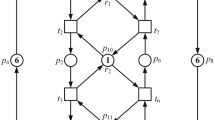Abstract
This paper addresses the problem of real-time deadlock-free scheduling for a semiconductor track system. The system is required to process wafers continuously, cassette by cassette. The process is not necessarily a repeated one. In addition, the system is deadlock-prone and its modules are failure-prone. Thus, real-time scheduling approaches are required to achieve high-performance. The problem can be solved in a hierarchical way. A deadlock avoidance policy is developed for the system as a lower-layer controller. With the support of the deadlock avoidance policy, heuristic rules are proposed to schedule the system in real-time. An effective modeling tool, colored–timed resource-oriented Petri net, is presented. It is shown that with this model we can schedule a system to achieve satisfactory results in real-time. This method is tolerant to module failures.









Similar content being viewed by others
References
Coffman EG Jr, Elphick MJ, Shoshani A (1972) System deadlocks. ACM Comput Surv 3(2):67–78
Cormen T, Leiserson C, Rivest R (1994) Introduction to algorithms. McGraw-Hill, New York
Fanti MP, Maione B, Mascolo S, Turchiano B (1997) Event-based feedback control for deadlock avoidance in flexible production systems. IEEE Trans Robot Autom 13:347–363
Jeng MD, Chen SC (1998) A heuristic search approach using approximate solutions of Petri net state equations for scheduling flexible manufacturing systems. Int J Flex Manuf Syst 10(2)
Johri PK (1993) Practical issues in scheduling and dispatching in semiconductor wafer fabrication. J Manuf Syst 12:74–485
Kim CO, Kim SS (1997) An effective real-time deadlock-free control for automated manufacturing systems. Int J Prod Res 35(6):1545–1560
Lawley MA (1999) Deadlock avoidance for production systems with flexible routing. IEEE Trans Robot Autom 15(3):497–509
Lawley M, Reveliotis S, Ferreira P (1998) A correct and scalable deadlock avoidance policy for flexible manufacturing systems. IEEE Trans Robot Autom 14:796–809
Lee DY, DiCesare F (1994) Scheduling flexible manufacturing system using Petri nets and heuristic search. IEEE Trans Robot Autom 10(2):123–132
Murata T (1989) Petri nets: properties, analysis, and application. Proc IEEE 77:541–579
Reveliotis SA, Ferreira PM (1996) Deadlock avoidance policies for automated manufacturing cells. IEEE Trans Robot Autom 12(6):845–857
Reveliotis SA, Lawley M, Ferreira P (1997) Polynomial complexity deadlock avoidance policies for sequential resource allocation systems. IEEE Trans Automat Contr 42:1344–1357
Roszkowska E, Jentink J (1993) Minimal restrictive deadlock avoidance in AMS. In: Proceedings of the 2nd European Control Conference ECC ’93, Groningen, pp 530–534
Wu NQ (1997) Avoiding deadlocks in automated manufacturing systems with shared material handling system. In: Proceedings of the 1997 IEEE International Conference on Robotics and Automation, Albuquerque, pp 2427–2433
Wu NQ (1999) Necessary and sufficient conditions for deadlock-free operation in flexible manufacturing systems using a colored Petri net model. IEEE Trans Syst Man Cybern Part C Appl Rev 29(2):192–204
Wu NQ, Zhou MC (2001) Avoiding deadlock and reducing starvation and blocking in automated manufacturing systems. IEEE Trans Robot Autom 17(5):658–669
Wysk RA, Yang NS, Joshi S (1991) Detection of deadlocks in flexible manufacturing cells. IEEE Trans Robot Autom 7(6):853–859
Xing KY, Hu BS, Chen HX (1996) Deadlock avoidance policy for Petri net modeling of flexible manufacturing systems with shared resources. IEEE Trans Automat Contr 41(2):289–295
Yoon HJ, Lee DY (2001) Identification of potential deadlock set in semiconductor track systems. In: Proceedings of the 2001 IEEE International Conference on Robotics and Automation, Seoul, 1820–1825
Yoon HJ, Lee DY (2004) Deadlock-free scheduling of photolithography equipment in semiconductor fabrication. IEEE Trans Semicond Manuf 17(1):42–54
Zhou MC, DiCesare F (1992) A hybrid methodology for synthesis of Petri nets for manufacturing systems. IEEE Trans Robot Autom 18(3):350–361
Zhou MC, Venkatesh K (1998) Modeling, simulation and control of flexible manufacturing systems: Petri net approach. World Scientific, Singapore
Acknowledgements
This work was supported in part by the Chinese National Science Foundation under Grant 60574066 and by the National Outstanding Young Scientist Research Awards under Grant 60228004.
Author information
Authors and Affiliations
Corresponding author
Rights and permissions
About this article
Cite this article
Wu, N., Zhou, M. Real-time deadlock-free scheduling for semiconductor track systems based on colored timed Petri nets. OR Spectrum 29, 421–443 (2007). https://doi.org/10.1007/s00291-006-0046-3
Published:
Issue Date:
DOI: https://doi.org/10.1007/s00291-006-0046-3




